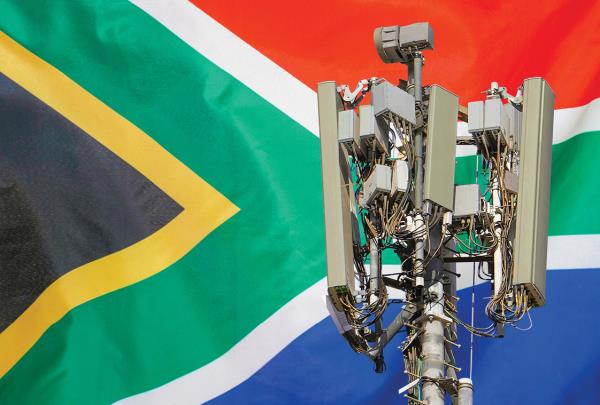12 July 2022

Recent floods in parts of South Africa have caused widespread devastation – putting critical communications under the spotlight. Robert Shepherd speaks to those keeping the continent connected
The tragedy of the recent floods in South Africa’s KwaZulu-Natal province brought critical communications to the fore – but not necessarily for the right reasons. Devastating landslides and gushing water damaged or completely destroyed north of 900 base stations for MTN and Vodacom alone. Not only did the ‘act of God’ and the resultant impact on the province’s infrastructure highlight the immediate benefits of a flexible internet telephony network, but many businesses were also left without critical communications to their employees.
As one can imagine, this made search and rescue missions even more difficult to conduct. In this most recent scenario, help was at hand courtesy of an unlikely and unorthodox hero – South African VOIP wholesaler, Wanatel, which highlights how voice over IP (VOIP) has risen to the challenge in these devastating scenarios. A cloud-based VOIP PBX (private branch exchange) system uses the internet to make calls, so it doesn’t require nearly as much physical infrastructure or hardware as a traditional phone system. Furthermore, it also allows businesses to make or take calls from anywhere on any internet-enabled device, regardless of location.

Mladen Vratonjić, TCCA
“It has been proven time and time again, all around the world, that having robust and reliable communications systems is essential when managing major events, whether planned or unplanned”
“We teamed up to assist our network of resellers in KZN in diverting calls, facilitating rerouting to other branches or mobile contact numbers,” Evan Damon, wholesale channel manager for Wanatel said at the time. “Usually our resellers run their own customer networks, using the functionality behind the scenes to manage customer VOIP accounts. This week, though, it was all hands on deck, to support and help every reseller to get their customers connected as quickly as possible.” Damon points out that the flexibility of a cloud-based VOIP system is the key. By redirecting calls, changing top-ups to accounts and ensuring communications are essentially rerouted to avoid outage, communication can be reinstated and diverted from damaged or destroyed infrastructure.
Of course, when it comes to mission critical situations, nothing is more important than the emergency services because we’re talking about life and death situations. So, when it comes to the response to disasters, it’s only natural that questions will be asked about the state of mission-critical networks the length and breadth of Africa.
Mobile network operator Vodacom won plaudits back in 2017 when the Midrand-headquartered telco Vodacom successfully demonstrated the first broadband multimedia trunking solution on a commercial LTE network in Africa. The solution makes it easier and faster for public safety industry to communicate and it incorporates latest multimedia functions which makes it quick to avert disaster situations.
Vodacom partnered with Chinese tech giant Huawei for the demonstration to use Huawei’s LTE integrated Trunked Radio (LiTRA) application to demonstrate a broadband multimedia trunking solution which runs on the operator’s commercial, nationwide LTE network.
That said, it was five-years-ago and things have moved on since – not to mention a number of disasters.
No country or continent is more important than the next, but when it comes to natural disasters, countries with inferior infrastructure will be hit hardest by natural disasters. Africa houses most of these nations. In other words, one could argue that some countries need robust critical comms more than others. Time for some facts.

The World Bank Group, Africa’s Pulse, October 2021 edition reveals that, overall, when it comes to climate-related natural disasters, droughts have affected the most people. What’s more, it’s primarily those living in the Horn, Sahel, and southern regions on the continent.
After droughts, flooding incidents affect the most people across the continent, even if they are concentrated in a few countries: Kenya, South Africa, and Mozambique experienced 75% of the region’s floods and storms. Notably, Kenya and South Africa individually were most affected by drought.
Somalia experienced the highest death toll from natural disasters, due to its 2010 drought. Mozambique had the second-highest death toll, largely caused by Cyclone Idai that battered the country in 2019.
“It has been proven time and time again, all around the world, that having robust and reliable communications systems is essential when managing major events, whether planned or unplanned,” says Mladen Vratonjić, board chair of TCCA, the global representation organisation for the critical communications ecosystem. “TCCA is a strong advocate of open standards technology. This encourages competition, helping to keep quality levels up and costs down, ensuring a wide choice of suppliers, catalysing innovation and preventing the emergence of expensive proprietary products. We would urge governments of all African countries to ensure they are implementing the best possible services for their first responders and emergency services – the quality of the communications can be the difference between effectively managing a crisis situation, or seeing a disaster turn into a tragedy.”
Paul Ward, director of international commercial and marketing activity for ETELM, a manufacturer of TETRA infrastructure technology based in Paris, France, says his company has a rich history on the continent.
“ETELM has supplied many mission-critical communications infrastructure solutions to the Africa region for over 30 years,” he explains. “We supply essential communications for a variety of sectors in the region including transportation, oil & gas and security applications. We recently supplied a complete mission critical system to Kenya Wildlife for protection of endangered animals against poaching etc. This is a critical application in providing communications to support anti-poaching operations to optimise the task of preventing poaching of all endangered wildlife in the area.”
Another key supplier in Africa is Sepura, which operates in the transport and utilities sector, providing tough radios in hazardous, heavy use environments.
To give you an idea as to Sepura’s pedigree in Africa; in 2010 kitted out South African police when the country hosted the FIFA World Cup.
Three years later, Sepura has won a contract to provide mobile radios to the South African Police Service (SAPS) throughout the Gauteng province.
In 2020, Sepura partner Consort Digital deployed a complete communications solution to the island of Mauritius, providing voice and data communications via Sepura TETRA radios to the new Mauritius Metro Express.

Josep Jonch, Teltronic
“In Africa, the problem we have encountered in our not so extensive experience is that investments often depend on subsidies or require the participation of a wide range of actors, which tends to slow down projects a lot”
“Our mobile and hand-held radios are used by rail, metro and bus organisations to ensure their staff are kept safe and in contact with the control rooms during operations. Sepura also operates within public safety,” says Terence Ledger, worldwide sales director, Sepura.
You’d be forgiven for thinking mainly foreign companies are responsible for the inner workings of Africa’s mission critical delivery and infrastructure. Enter Altron Nexus of Sandton, South Africa, which delivers resilient and feature-rich solutions to various critical sectors of the economy, including the public safety sector, rail and road transportation services, mining and energy industries and commercial and retail groups. In terms of critical comms networks and devices, the company builds and operate a wide variety of network technologies including TETRA, digital mobile radio (DMR), GSM-R Rail Mission Critical network, and push-to-talk/video over cellular (PoC).

Kennedy Chinganya, Altron Nexus
“Our technology has played an integral part in the emergency responders’ ability to operate – for example the rapid response to the recent Parliament Building fire in Cape Town was due to our systems operating within the City of Cape Town’s Emergency Response Centre”
Kennedy Chinganya, managing director, Altron Nexus says his company offers “the full stack of critical comms applications” including command and control platforms such as computer aided dispatch, intelligent video surveillance, biometric access control, remote control centres and integration with other customer specific systems.
“We provide a holistic offering taking into consideration the full spectrum of our customers’ typical needs, these are then tailored toward clients’ specific requirements through our professional services and managed services capabilities,” he adds.
Chinganya cites examples of where Altron Nexus has deployed several networks within the safety and security sector. “Our technology has played an integral part in the emergency responders’ ability to operate – for example the rapid response to the recent Parliament Building fire in Cape Town was due to our systems operating within the City of Cape Town’s Emergency Response Centre,” he says. “During the riots and the recent flooding disasters in KZN our DMR networks showed incredible resilience allowing the users to maintain operations. Looking further back, Altron Nexus assisted with deployment of equipment for the Knysna fires during June 2017. Assistance was provided to a number of municipal governments with our Push-to-Talk Over Cellular (PoC) and DMR solutions during the Covid-19 pandemic.”
Ledger says that although “we can’t quote or reference any specific occasions as we do not have the customer permission to do this”, he does talk generically about Sepura radios being used in a couple of general situations. ”The (Sepura’s) radios are used by police/fire/ambulance teams to aid operations as they occur, which can be civil disobedience, natural disasters, etc.” he adds.
Still, that’s not to say deployment isn’t without its problems. After all, Africa’s terrain doesn’t always lend itself well to technology, signals etc.

“Availability of frequency can be problematic – especially in Africa the availability of UHF frequency can be an issue,” Ledger adds. “Other than that, the main issues are the same as anywhere – budget, experience and environmental issues to consider, ensuring that the most appropriate solution is understood and deployed by the customer.”
Kennedy explains how “the prospects to deploy mission critical communications and infrastructure is in high demand across Africa” when looking at various countries and their requirements and dependencies. He adds that to take advantage of this, an effective enabling environment is essential. “The critical communications sector is a particularly important contributor to modern economies as it enhances resilience, productivity and sustainability within these critical verticals we’ve mentioned,” Kennedy continues. “Africa is a region with extremely high potential, but there are still certain social and infrastructural deficits that hamper the growth prospects. The overall impression is of progress but, as mentioned above and highlighted through the challenges, Africa lags behind most other regions – there’s work to do.”
When it comes to the main cultural, social and political issues encountered when trying to deploy critical comms kit and networks in Africa, Kennedy says that further to those he has already mentioned, it’s important to emphasise two issues.
“Firstly, due to relatively low per capita GDP and low economic growth rates on average, public sector agencies struggle to access sufficient funding for these projects.,” Kennedy continues. “At Altron Nexus we are always available to assist in consulting and assisting with business and operating models that make these more feasible. Secondly, such critical comms networks tend to be much needed in areas of political and social upheaval and this makes the deployment and operation of these networks especially challenging – issues such as theft, vandalism and violence in certain areas, for example one of our projects in northern Mozambique.”
Kennedy says One of the biggest challenges involves a limited base of skilled resources to deploy and operate these solutions – we continue to build up a skilled workforce and make efforts towards enhancing education and training levels to mitigate this while enhancing livelihoods.
Another challenge is relatively poor infrastructure. Road and rail infrastructure is not always in good condition, which makes transporting goods and skilled staff difficult for certain deployments. This also creates challenges with regards to the lack of access to electricity in certain areas in Africa, where alternative solutions need to be developed which in turn increases deployment costs and timelines.
Ward says “As we have supplied systems for railways and oil and gas, the technology is often deployed in remote un-manned stations,” adds Ward. “Due to the vastness of the region many sites are some distance away from personnel, security of equipment can be a particular issue - so remote/security monitoring and CCTV transmission are requirements essential to ensure the integrity of the system.”
Theunis Botha, who works on the sales & IT teams at Africa Radio Distributors, a distributor and reseller of various RF related technologies and products, says there are three main issues.

Theunis Botha, Africa Radio Distributors
“Purchasing in our currencies at United States dollar rates will keep Africa from delivering critical communication where needed most”
The first is cost. “Although it is a definite contributor to the struggles of deploying critical communications systems, it is not the only deterrent,” he says. “Some projects would have funding made available, and usually it is from an international source. The products available are trusted, tested and tried in many environments in other non-African countries and has become the benchmark for solutions deployed locally. There would be a lot more of these deployments if we had locally developed solutions and products to match the benchmark solutions at an ‘African’ cost. Purchasing in our currencies at United States dollar rates will keep Africa from delivering critical communication where needed most.”
Another issue is stock and product availability – or lack thereof. “It is well known that Africa doesn’t get first pick with a lot of things,” Botha adds. “When there are stock shortages like the one experienced currently, one feels that we would be the last to receive deliveries. Decreased supply/manufacturing capabilities of most OEM that we distribute is not nearly meeting the demand experienced from almost all industry verticals. Back orders and resultant lead times are at an all-time high, and risk of cancellation of existing projects is an inevitable end to some projects. Lacking availability of best-in-class solutions and products, puts Africa further behind in terms of what we can deploy as a solution.
Last but by no means least, Botha cites education/expertise. He argues that not enough skilled people in the areas where deployment takes place. “If the knowledge of solutions was available to more semi-skilled workers, the solutions delivered would be so much better,” Botha says. “A lot of training is available online but once again the internationalisation of the cost makes it difficult for your average African service provider to obtain the skills necessary to supply, deploy and even propose the best suited solutions. This does not consider the difficulty in deploying a scoped solution effectively and accurately. This might even cause a disparity between the engineered and delivered solution, which will result in distrust of the technologies and/or OEM involved with the failed solution.”
Another seasoned vendor in this space is ST Engineering iDirect, a provider of VSAT ground infrastructure and technology innovations to the world’s satellite operators and service providers. It prides itself on providing solutions to enable end users to quickly deploy satellite communications anywhere in the world.
“Satellite connectivity is critical for first response efforts, especially when terrestrial networks are destroyed or are unavailable,” says Pieter-Paul Mooijman, regional vice president, Africa, ST Engineering iDirect. “First response teams may use satellite connectivity on-the-move to build situational awareness, at a disaster site to coordinate lifesaving efforts, and after a disaster to assist recovery operations. As emerging technologies are introduced to disaster response—such as drones and IoT devices—greater bandwidth is needed.”
ST Engineering iDirect and its broader ecosystem partners (VSAT network operators/service providers and integrators) actively participate in emergency response situations globally.
“The ST Engineering iDirect platform is designed for network operators to meet a broad range of customer requirements from narrowband to demanding high-bandwidth applications across all markets,” adds the spokesman.
Teltronic is a Spanish company with almost 50 years of experience in the design, development and manufacture of integral communication solutions has had more opportunities in the transport sector than in public safety and emergency attention.
“In Africa, some of our references are the Algiers Metro, or the tramways of Oran and Constantine (all of them in Algeria) as well as the Moatize-Nacala line, a mining train with more than 900 kilometres of track along the jungle of Mozambique and Malawi, which was a real challenge for us,” says Josep Jonch, sales director, at Teltronic. “In public safety, we have some references in Mozambique, Botswana and South Africa.
Jonch also talks about challenges faced by mainly foreign companies.
“We think that the great challenges come from the cultural differences that exist; it is not something that happens only to Teltronic, but also to many Spanish and European companies,” he adds. “In Africa, the problem we have encountered in our not so extensive experience is that investments often depend on subsidies or require the participation of a wide range of actors, which tends to slow down projects a lot.”
While Africa does continue to face challenges in the critical comms space - be they cultural, financial, political or something else, the will is there. Like many things, progress takes time.







